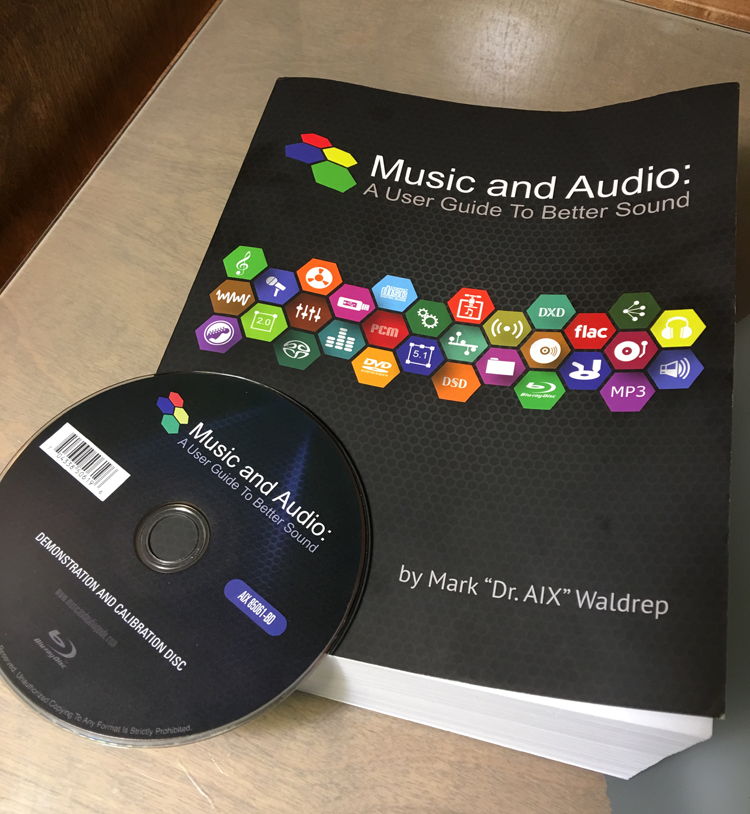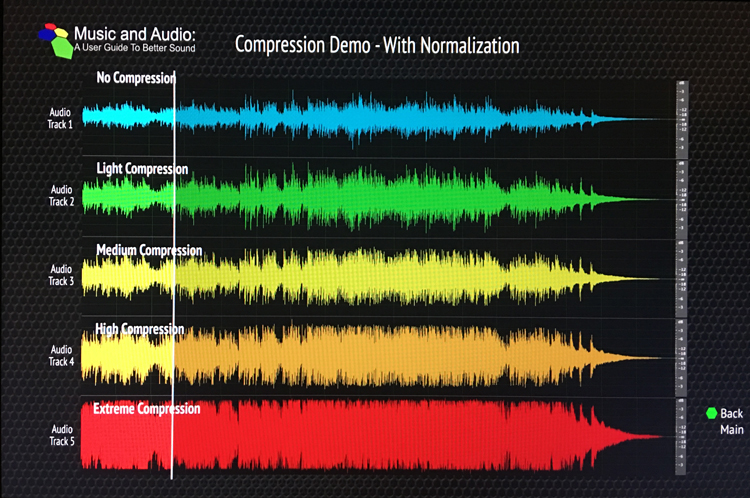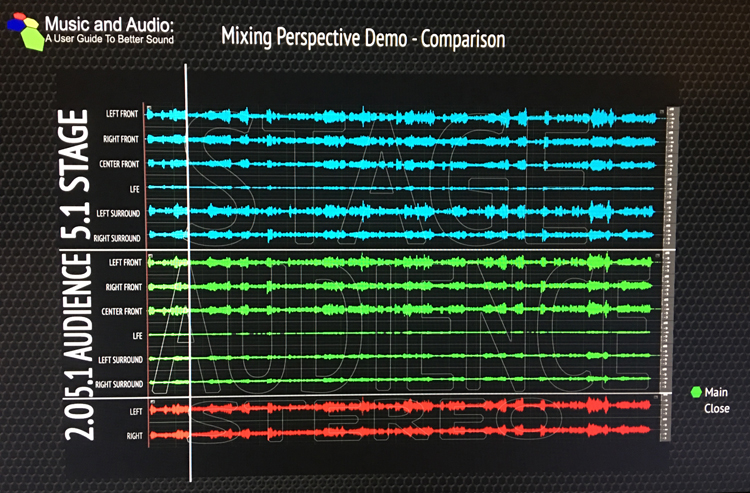
Music and Audio: A User Guide To Better Sound
By Mark “Dr. AIX” Waldrep
Book Review
I say this not as hyperbole but as a qualitative and quantitative statement of fact. His numerous recordings, covering many genres of music, check off all the right boxes of what audiophiles had been hoping and expecting of the coming high-resolution music wave.
- Pristine quality 96kHz/24-bit PCM digital audio recording with great fidelity, range and dynamics.
- Both 2-channel stereo and two discrete 5.1 channel mixes on each disc.
- A choice of two distinct surround mixes to experience (“Stage” and “Audience” POV), on the same disc. How cool is that?!
- Video bonus material ranging from simple session video clips to fully recorded and edited session video in HD. There’s even a few discs in Blu-ray 3D!
- Mark’s recordings are good enough that I, and more than a few other Secrets reviewers, use them as reference material when evaluating equipment in our reviews.
Mark makes no bones about being a high-resolution audio evangelist, and a rather opinionated one at that. His long-running Real-HD Audio Blog has given him the opportunity to extoll the virtues of what high-resolution recording should be and to dispel a number of audio myths and misconceptions that he feels are out there in the enthusiast world. A quick read through a few of Mark’s blog articles and you’ll soon get a sense that he has little time for the ephemeral, nuanced benefits wrought by boutique cables, voodoo audio accessories and the like. Mark lives in the real world and values empirical evidence along with a good dose of common sense.
Beyond his music producing and audio engineering credentials, Mark is also a “man of letters.” The “Doctor” in the “Dr. AIX” moniker is not just for show. Dr. Waldrep possesses multiple academic degrees including a Ph.D. in Music Composition, a Master of Science in Computer Science, and a degree in 3D Art. He currently heads the Audio Recording Program at CSU Dominguez Hills in Southern California and has been teaching there for over 20 years. It is therefore safe to assume that he knows of which he speaks.
Secrets Sponsor
About three years ago, Mark decided that he wanted to expand beyond what he was doing on his blog and create a more permanent free-standing reference guide on the subject of high-resolution audio. In order to dispel much of the misinformation on hi-res audio that Mark felt was online and in print, the book grew in scope to cover every facet of the high-resolution audio chain from music making and recording to production and final playback in the home. Along with the 850-page book, an accompanying Blu-ray disc includes high-resolution sample tracks from the AIX Records catalog, test tones, examples of music production techniques, different types of mastering examples, audio formats and more. Mark launched a Kickstarter campaign in September of 2015 to raise money for the book project. The project met its funding targets in short order and, after a respectable gestation period, the books began shipping out to customers early last month.
Author:
Mark “Dr. AIX” Waldrep
Publisher:
AIX Publishing
ISBN:
978-0-9973566-0-1
Pages:
850
MSRP:
$79.95 for Paperback book and Blu-Ray disk (e-book and downloadable files also available at reduced price points.)
SECRETS Tags:
Music and Audio, Guide, Reference, High-Resolution Audio, Mark “Dr. AIX” Waldrep, Book Review 2018

When I first started getting serious about this hobby, I was midway through my high school years. In 1980’s Toronto, I had everything handy to get me started down the audiophile rabbit hole. Plenty of great independent audio stores, a healthy local live concert scene, an appreciation of aesthetics via my budding visual art talents, and a penchant to dissect my mother’s transistor radios when she wasn’t looking! There was no internet, of course, and audio publishing was still alive and well, so I was looking to fortify my knowledge with whatever information I could lay my hands on. I would buy copies of Audio magazine from the local store every month and my school library had a subscription to Alan Loft’s Sound & Vision Canada magazine that I pretty much had free reign to sign out. I soon added Peter Aczel’s The Audio Critic to my digest of regular audio reading. The thing about these three magazines that appealed to me so much was that the writing was always very good, the selection of gear they covered caught my fancy and included stuff that I could aspire to afford, but also that they covered technical subjects in a manner that made it easy for me to grasp and understand.
Sound & Vision Canada was particularly good at this. The CD and digital audio revolution was just in it’s infancy at this point and I found the technical explanations about the transition from analog to digital audio particularly fascinating. Audio magazine had great articles with insights into the recording and production end of things as well. I momentarily toyed around with the idea of becoming an audio engineer because of them. The Audio Critic was easily the most unapologetically biased (almost irreverently) in the grounding of audio reviewing to fact-based analysis. My Secrets colleague, Dr. David Rich wrote deep technical articles for The Audio Critic about preamplifier and amplifier designs that I still pop back and refer to from time to time. These magazines, and occasionally others, formed the basis of my appreciation for audio as a hobby. I could find reference books about audio production or DIY audio projects at the city libraries, but they tended to be dry and hard to follow, so they had a hard time holding my attention for more than a chapter. Having now had the chance to go through “Music and Audio: A User Guide To Better Sound” from stem-to-stern, all I can say is I wish that I had something like this when I was in high school!
What Mark Waldrep has done in writing this book is create a one-stop reference work for the audiophile. A book clearly aimed at those of us who wish to enjoy the music we love in the best way that we possibly can. It is equal parts technical (diving in to the fundamentals of music and audio theory, the specifics of classic and modern musical production techniques, mastering and delivery) and opinion (Mark is very upfront about his views on what high-resolution audio is and isn’t along with his takes on different music formats, technologies and the like). But it is written in a way that makes it an eminently enjoyable read and with technical sections broken down in a manner that allows the information to be easily digestible and retainable for a right-brained fellow such as myself. You can tell that the material has been laid out by a teacher and that it is backed by experience acquired through years in the field. Much of the technical writing is interspersed with relevant stories or anecdotes from Mark’s career which adds interest and helps such a “deep” and detailed book flow.
Secrets Sponsor
The book’s introduction begins with a seemingly simple question, “What is fidelity?” As an audio reviewer and hobbyist, I like to think that fidelity (in this context) means, having my system faithfully reproduce the music I am listening to as completely as possible. I, along with most other audiophiles, will nerd over the latest speaker, amp, DAC or other equipment that we feel will bring us closer to that goal. And “Music and Audio” has chapters in it exclusively devoted to consumer audio gear. Each one breaks down different categories of audio equipment and discusses various specifications, design choices, setup best practices, etc. There’s even an excellent section on room acoustics and acoustic treatments. But achieving fidelity, in a larger sense, is greatly dependent on the source material that we feed into our audio systems. Mark’s book spends a large part covering the various ways music has been recorded along with the ways it’s processed for various delivery systems and the strengths and limitations of each format. And I mean it covers everything – from different microphone recording patterns and mic pre-amp choices, to whether your music ends up as a vinyl LP or a high-resolution digital audio file, along with every possible step and production choice in between. It also gets pointed out what choices are dependent on artist intent and what are dependent on industry practices. I particularly appreciate how Mark breaks down digital recording, both in documenting the history of its evolution and in the fundamental theory of it. He also goes into great detail about all the various tools used in modern digital recording and how the various components work. Analog recording aficionados fear not! You also get a good deal of page space devoted to analog recording techniques and all things tape-related as well.
If you asked Mark Waldrep point blank, he would most likely tell you that the best modern format to record music on is 96 kHz/24-bit PCM digital. He would also tell you much of what is billed as “high-resolution” audio actually isn’t, fussing over boutique analog or digital audio cables is a waste of time and money, and that MQA is essentially a sham. These opinions may not be fashionable with a number of audiophiles (or some of my colleagues in the press), but they are honest opinions, derived from experience and concisely broken down, backed up, and explained throughout the book. Mark actually devotes an entire chapter to MQA and it’s a complete and thorough analysis.
The book is further enhanced with a Blu-Ray disc. The first chapter (almost 100 pages) in the book is devoted to the disc’s contents and delves into detail about the features. To start, the disc contains 13 complete high-resolution tracks from the AIX catalog. These tracks are available to be heard in either two-channel stereo or in one of two different surround sound perspectives, Stage and Audience. The corresponding chapter relays anecdotes and breaks down several technical details about each track including dynamic range waveforms and frequency plots.



There is a section on the disc called Mastering Comparison that allows a listener to experience five different levels of audio compression on the same track. Instantly switching between the different levels as the track plays provides an effective method of showing how dynamic range can be compromised in a recording for the sake of loudness. Another section called Format Comparisons allows one to switch between six different format versions of the same AIX audio track as it plays. The versions to choose from are: Hi-Res Original 24/96 Stereo PCM, CD Audio 16/44.1 Stereo, Analog Tape 24/96 Stereo, MP3 320kbps Stereo, MP3 256 kbps, and MP3 128 kbps. Again, the book goes into great detail about each choice. I listened to this section with headphones to see if I could pick out the differences. Analog Tape surprised me. It had a noticeably different sound, but not in a bad sense – just “warmer” sounding to my ears. The next section, Mixing Comparison, allows the user to switch between stereo and either of the Stage or Audience surround modes on the included track. The remaining Test Tones section has various calibration tones and frequency sweeps to help properly establish a surround system.
Mark’s book closes with its last chapter appropriately titled “Meet the Experts.” In this section Mark includes interviews that he has had with 12 industry veterans, whose experience run the gambit from music recording and engineering, to mastering, room acoustics, digital signal theory, and professional/consumer audio equipment design and manufacture. Those folks are:
– Robert Stuart: Meridian and MQA
– Andreas Koch: Playback Designs
– Richard Schram: Parasound Products
– John Siau: Benchmark Digital
– Brian Lucey: Magic Garden Mastering
– Gavin Lurssen: Gavin Lurssen Mastering
– Sam Berkow: SIA Acoustics
– Bob Hodas: Bob Hodas Acoustic Analysis
– Ken Caillat: Grammy-winning engineer
– Robert Margouleff: Grammy-winning engineer
– Jonathan Reichbach: Sonic Studio/Amarra
– John Keane: Musician, producer, Emmy-nominated composer
Many of these feature interviews were conducted expressly for the book and a few of these contributors have differing opinions to Mark’s when it comes to the subject of high-resolution audio. Yet, differing opinion or not, I found all the observations and insights from these industry experts to be a valuable addition to the book. It’s always illuminating to get a window into the mind of a person who is noted in their field and get a sense of where their experience has taken them.
In a larger sense, Music and Audio is a scrupulously written tome that re-affirms the old axiom “Garbage In, Garbage Out.” Probably the most important part of a good sounding audio system, is to start with an excellent recording. Mark has surely thrown down the gauntlet with his book, to outline, once and for all and from start to finish, this is how it’s done. Whether our music is sourced from analog tape, which the technical specs of the compact disc will more than cover, or comes from new high-resolution recordings, this book spells out what we as audiophile consumers should be honestly expecting from the music industry. Whether we get there or not, is anybody’s guess. The experience gained from the failure of DVD-AUDIO and SACD as viable high-resolution formats doesn’t paint a rosy picture. And when I interviewed Mark by phone (a transcript is to be released shortly after this review), he said that he is retiring from producing new AIX recordings. He believes that through the existing catalog that AIX Records has built up, he has made his point on what is possible with high-resolution audio. It’s become cost and time prohibitive to continue with any new recording projects. Mark is currently consulting with a company called Comhear on the new YARRA 3DX beamforming 3D Audio sound bar.
In any event, I find Music and Audio: A User Guide To Better Sound to be an invaluable reference tool for any audiophile who cares about their system and what they play on it. Buy it! It is an enjoyable and informative read that covers everything under the sun that is meaningful about audio. I know I will refer to my copy often in the years to come. Hopefully many others, both consumer and professionals alike, will feel the same way about it as I do. Maybe even that kid who’s currently in high school…


